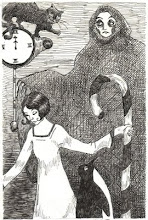How much digital ink, I wonder, has been spilled in praise of Christina Hendricks and Joan Holloway, the fascinating character she plays? Gallons of pixels I warrant, and the bulk of them talk about her body. Which is glorious:
 Photobucket" border="0">
Photobucket" border="0">
Look. I'm not going to go off on a rant about
sample sizes, or about various body types or parts being in or out of style (short arms are in for Fall!) or any of that, mostly because I want to write about Joan in 1965, not Christina in 2010 (though I do have a post about the fashion of female beauty aesthetics in the works, and may talk more about her there).
What I wanted to talk about was office politics or, more specifically, Joan and Peggy's respective places within Sterling Cooper Draper Pryce. Don Draper is a partner and the head of creative. From what I've gathered, Peggy is his second in command, hiring mostly freelancers (both copywriters and illustrators).
Jonathan was hired a few episodes ago, but we haven’t really seen him since. So, all the young creatives sit around a typical writers’ room, throwing ideas around, bullshitting, the usual. It’s 1965 and the vibe is far more relaxed and laid back and, well, modern than it was at the old firm in the pre-Beatles years.
Joan is the office manager, inhabiting a space I know all too well. Upper management knows she’s invaluable: smart, ultra-competent, a born fixer. But the (mostly male) rank and file behave as if she’s just some fucking secretary who has the gall to think she’s more important than, say, some freelancer out of Harvard who could be replaced in an instant. She’s not management, not staff, not creative, but is instead in some kind of twilight zone in which she is utterly unreplacable, but ill-defined in terms of office hierarchy.
Back to the writer’s room. All of the creative team are men except for Peggy. Their room is separated from Joan’s office by a glass wall. Lots of silliness happens when they are all trying to work through problems and come up with ideas, which is inevitable and good for any creative process. The mid-sixties are far looser and more permissive in style than the 50s and most of us think of that as being a good thing, but inevitably, when certain social strictures are loosened, what comes spilling out isn’t limited to wacky brilliance, ugliness is unleashed as well. One of the freelancers in particular is a total creep. This is a dynamic most women have encountered. You are the only women in the group. Most of the men are pretty reasonable, and than one total asshole starts making all kinds of ugly, hateful sexist jokes and all the previously reasonable men join in. It’s maddening and puts you in an impossible situation. If you let it go, you die a little inside. If you complain, you are a humorless scold. You cannot win. I have personally solved this problem by not giving the tiniest damn if people thing I am a humorless scold. But, I’m almost fifteen years older than Peggy, living in very different times.
Peggy is in a quandary. Then, the creepy, creepy jerk decides he has a particular problem with Joan after she yells at the little boys in creative for screwing with the snack machine, turning their workspace into a pig sty, using her office as a through way, etc. This guy has admitted Mommy problems and goes fairly psycho. Peggy yells at him for being a jerk to Joan, and he (of course) responds by belittling her. Joan takes him aside to have a word, and he says “What exactly do you do around here besides walking around looking like you want to get raped?” This guy is a total jerk, but the thing that struck me most is that within the hierarchy of SCDP he is subordinate to
both Peggy and Joan. We have a word for this and it’s called
privilege. This is a person whose privilege runs so deep, he is sexually harassing his superiors, and oh my friends, this is a situation I have been in and it’s simply mind boggling.
Finally, the insufferable freelancer goes too far. He draws a cartoon of Joan giving someone a blowjob and tapes it to the window of her office. It’s always struck me how men like that are so adept at zeroing in on someone’s insecurities. Joan is the most competent person imaginable, but her former sexual relationship with Roger Sterling puts her in s slightly unfortunate position in terms of power dynamics. Both Joan and Peggy absolutely lose it, understandably. Joan storms in and tells all the boys that when they get drafted and go to Vietnam and get killed she, for one, will be happy about it. Not nice, no, but her husband is being deployed that week and she’s been pushed pretty far.
Peggy goes to Don. This is where it gets really interesting. He clearly doesn’t think it’s that big a deal and really doesn’t want to deal with it. But in deflecting the situation away from him, gives Peggy some excellent advice. He says: ”Fire him.” When she looks taken aback he says (okay, I’m paraphrasing), “If I fire him, you’ll look like a tattletale. Is that what you want?” Peggy calls the asshole freelancer aside and tells him that he’s behaving inappropriately and that he needs to apologize to both her and Joan. He refuses and makes
yet another smart remark, clearly not understanding that he is, in fact, talking to his boss. So Peggy fires him. It’s awesome. He clearly doesn’t believe she has the authority to do so as she’s sporting a vagina and all. So he says, we’ll see what Don has to say about that. She responds, “Don doesn’t even know who you are.” And at that moment her eyes are shooting off magical feminist laser beams of power and it’s just thrilling.
The final grace note of the episode is what really makes it. Peggy is clearly buzzing from the excellent firing and gets on the elevator with the still clearly upset Joan. Peggy obviously wants to share a happy “ding dong the manwitch is dead” moment with her, but Joan is having none of it. She tells Peggy she could have handled it herself by having one dinner with the client and having a private word with him and Peggy, by doing what she did has only proved that Joan is “just some powerless secretary and that she [Peggy] is a humorless bitch”. Poor Joan. She’s basically espousing that age old anti-feminist rhetoric that women can get whatever they want through their feminine wiles and getting men to act for him. And this is a perfect example why I have exactly zero problem with being a humorless bitch. As I discussed in a previous blog post about calling a woman a
stupid slut, there are the same three reasons to call a woman a humorless bitch:
- To shut her up.
- To discredit what she's saying or doing
- To humiliate her.
What Peggy really needs to do, is to hire more women. Seriously.
 There are few, if any, movies I've seen more times than Some Like It Hot. Honestly, I feel as if I had the whole thing pretty much by heart by the time I was 10. I wrote at least one paper on it when I was at NYU. It's just the best.
There are few, if any, movies I've seen more times than Some Like It Hot. Honestly, I feel as if I had the whole thing pretty much by heart by the time I was 10. I wrote at least one paper on it when I was at NYU. It's just the best.




 Photobucket" border="0">
Photobucket" border="0">


























